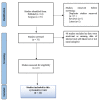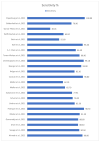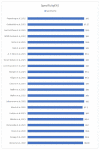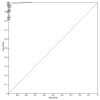The Diagnostic Accuracy of SARS-CoV-2 Nasal Rapid Antigen Self-Test: A Systematic Review and Meta-Analysis
- PMID: 36836639
- PMCID: PMC9961889
- DOI: 10.3390/life13020281
The Diagnostic Accuracy of SARS-CoV-2 Nasal Rapid Antigen Self-Test: A Systematic Review and Meta-Analysis
Abstract
Introduction: Severe acute respiratory syndrome coronavirus 2 (SARS-CoV-2) is the cause of coronavirus disease 2019 (COVID-19), a disease that quickly spread into a pandemic. As such, management of the COVID-19 pandemic is deemed necessary, and it can be achieved by using reliable diagnostic tests for SARS-CoV-2. The gold standard for the diagnosis of SARS-CoV-2 is a molecular detection test using the reverse transcription polymerase chain reaction technique (rt-PCR), which is characterized by various disadvantages in contrast with the self-taken nasal rapid antigen tests that produce results faster, have lower costs and do not require specialized personnel. Therefore, the usefulness of self-taken rapid antigen tests is indisputable in disease management, facilitating both the health system and the examinees. Our systematic review aims to access the diagnostic accuracy of the self-taken nasal rapid antigen tests.
Methods: This systematic review was conducted following the Preferred Reporting Items for Systematic Reviews and Meta-Analyses (PRISMA) guidelines, and the Quality Assessment of Diagnostic Accuracy Studies 2 (QUADAS-2) tool was used to assess the risk of bias in the included studies. All the studies included in this systematic review were found after searching the two databases, Scopus and PubΜed. All but original articles were excluded from this systematic review, while all the studies concerning self-taken rapid antigen tests with a nasal sample and using rt-PCR as a reference test were included. Meta-analysis results and plots were obtained using RevMan software and the MetaDTA website.
Results: All 22 studies included in this meta-analysis demonstrated a specificity of self-taken rapid antigen tests greater than 98%, which exceeds the minimum required yield for the diagnosis of SARS-CoV-2, according to the WHO. Notwithstanding, the sensitivity varies (from 40% to 98.7%), which makes them in some cases unsuitable for the diagnosis of positive cases. In the majority of the studies, the minimum required performance set by the WHO was achieved, which is 80% compared with rt-PCR tests. The pooled sensitivity of self-taken nasal rapid antigen tests was calculated as 91.1% and the pooled specificity was 99.5%.
Conclusions: In conclusion, self-taken nasal rapid antigen tests have many advantages over rt-PCR tests, such as those related to the rapid reading of the results and their low cost. They also have considerable specificity and some self-taken rapid antigen test kits also have remarkable sensitivity. Consequently, self-taken rapid antigen tests have a wide range of utility but are not able to completely replace rt-PCR tests.
Keywords: SARS-CoV-2; antigen self-test; diagnostic accuracy; rt-PCR.
Conflict of interest statement
The authors declare no conflict of interest.
Figures







Similar articles
-
[Evaluation of the Rapid Antigen Detection Kit with the Polymerase Chain Reaction for Detection of SARS-CoV-2 in Respiratory Samples].Mikrobiyol Bul. 2022 Apr;56(2):263-273. doi: 10.5578/mb.20229806. Mikrobiyol Bul. 2022. PMID: 35477229 Turkish.
-
Diagnostic accuracy of rapid point-of-care tests for diagnosis of current SARS-CoV-2 infections in children: a systematic review and meta-analysis.BMJ Evid Based Med. 2022 Oct;27(5):274-287. doi: 10.1136/bmjebm-2021-111828. Epub 2022 Jan 18. BMJ Evid Based Med. 2022. PMID: 35042748 Free PMC article.
-
Thoracic imaging tests for the diagnosis of COVID-19.Cochrane Database Syst Rev. 2020 Sep 30;9:CD013639. doi: 10.1002/14651858.CD013639.pub2. Cochrane Database Syst Rev. 2020. Update in: Cochrane Database Syst Rev. 2020 Nov 26;11:CD013639. doi: 10.1002/14651858.CD013639.pub3. PMID: 32997361 Updated.
-
A prospective clinical evaluation of the diagnostic accuracy of the SARS-CoV-2 rapid antigen test using anterior nasal samples.J Infect Chemother. 2022 Jun;28(6):780-785. doi: 10.1016/j.jiac.2022.02.016. Epub 2022 Feb 24. J Infect Chemother. 2022. PMID: 35256268 Free PMC article.
-
Performance of self-performed SARS-CoV-2 rapid antigen test: a systematic review and meta-analysis.Front Public Health. 2024 Oct 18;12:1402949. doi: 10.3389/fpubh.2024.1402949. eCollection 2024. Front Public Health. 2024. PMID: 39494084 Free PMC article.
Cited by
-
Pooled analysis of diagnostic performance of the instrument-read Quidel Sofia SARS antigen Fluorescent Immunoassay (FIA).EJIFCC. 2023 Jul 10;34(2):123-141. eCollection 2023 Jul. EJIFCC. 2023. PMID: 37455844 Free PMC article. Review.
-
The Prevalence of Gastrointestinal Bleeding in COVID-19 Patients: A Systematic Review and Meta-Analysis.Medicina (Kaunas). 2023 Aug 21;59(8):1500. doi: 10.3390/medicina59081500. Medicina (Kaunas). 2023. PMID: 37629790 Free PMC article.
-
A comprehensive meta-analysis and systematic review of breath analysis in detection of COVID-19 through Volatile organic compounds.Diagn Microbiol Infect Dis. 2024 Jul;109(3):116309. doi: 10.1016/j.diagmicrobio.2024.116309. Epub 2024 Apr 27. Diagn Microbiol Infect Dis. 2024. PMID: 38692202 Free PMC article.
-
Risk of Testing Positive for COVID-19 among Healthcare and Healthcare-Related Workers.Vaccines (Basel). 2023 Jul 19;11(7):1260. doi: 10.3390/vaccines11071260. Vaccines (Basel). 2023. PMID: 37515075 Free PMC article.
-
Comparing SARS-CoV-2 antigen-detection rapid diagnostic tests for COVID-19 self-testing/self-sampling with molecular and professional-use tests: a systematic review and meta-analysis.Sci Rep. 2023 Dec 11;13(1):21913. doi: 10.1038/s41598-023-48892-x. Sci Rep. 2023. PMID: 38081881 Free PMC article.
References
-
- Song W.-J., Hui C.K.M., Hull J.H., Birring S.S., McGarvey L., Mazzone S.B., Chung K.F. Confronting COVID-19-associated cough and the post-COVID syndrome: Role of viral neurotropism, neuroinflammation, and neuroimmune responses. Lancet Respir. Med. 2021;9:533–544. doi: 10.1016/S2213-2600(21)00125-9. - DOI - PMC - PubMed
Publication types
LinkOut - more resources
Full Text Sources
Research Materials
Miscellaneous

